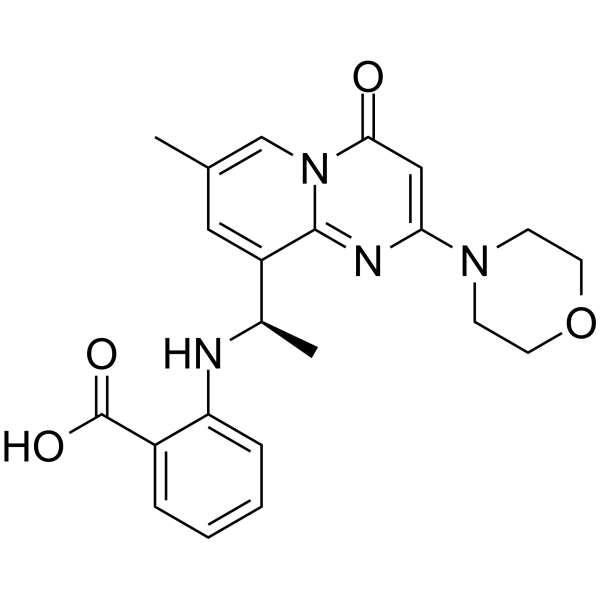Home
Products
AZD6482



| Product Name | AZD6482 |
| Price: | Inquiry |
| Catalog No.: | CN00299 |
| CAS No.: | 1173900-33-8 |
| Molecular Formula: | C22H24N4O4 |
| Molecular Weight: | 408.45 g/mol |
| Purity: | >=98% |
| Type of Compound: | Alkaloids |
| Physical Desc.: | Powder |
| Source: | |
| Solvent: | Chloroform, Dichloromethane, Ethyl Acetate, DMSO, Acetone, etc. |
| SMILES: | Cc1cc([C@H](Nc2ccccc2C(=O)O)C)c2n(c1)c(=O)cc(n2)N1CCOCC1 |
| Contact us | |
|---|---|
| First Name: | |
| Last Name: | |
| E-mail: | |
| Question: | |
| Description | AZD 6482 is a potent and selective p110β inhibitor with IC50 of 0.69 nM. |
| Target | PI3Kα:136 nM (IC50) PI3Kβ:0.69 nM (IC50) PI3Kδ:13.6 nM (IC50) PI3Kγ:47.8 nM (IC50) PI3K-C2β:54.1 nM (IC50) hVps34:3390 nM (IC50) DNA-PK:53.7 nM (IC50) PI4Kα:8830 nM (IC50) mTOR:3930 nM (IC50) Autophagy |
| In Vitro | An in vitrokinase assay demonstrates that AZD 6482 (KIN-193) is highly potent in the inhibition of p110β’s kinase activity (IC50 of 0.69 nM) and has 200, 20, and 70-fold selectivity over p110α, p110δ, and p110γ isoforms, respectively. AZD 6482 also exhibits selectivity of ~80 fold over PI3K-C2β and DNA-PK and more than 1,000-fold over other phosphatidylinositol-3 kinase–related kinases (PIKKs). An inhibitor-kinase interaction profiling of AZD 6482 against a panel of 433 kinases using the KinomeScan approach demonstrates that AZD 6482 is highly selective in its interaction with PI3Ks. To determine whether AZD 6482 selectively targets PTEN-deficient tumors, the effect of AZD 6482 is tested on cell proliferation on a large panel of 422 cancer cell lines using high-throughput tumor cell line profiling. 35% of cell lines with PTEN mutations (20 out of 57) and 16% of cell lines with wild-type PTEN (58 out of 365) are sensitive to AZD 6482 with a threshold of EC50<5 µM[1]. |
| In Vivo | To determine the pharmacodynamics of AZD 6482 (KIN-193) in tumors in vivo, rat fibroblast (Rat1) cells are engineered to express both p53DD, a dominant negative mutant of p53, and a constitutively activated myr-p110β (Rat1-CA-p110β) to enable these cells to form xenograft tumors in mice. For comparison, an isogenic Rat1 cell line expressing p53DD and myr-p110α (Rat1-CA-p110α) is also generated. Rat1-CA-p110α and Rat1-CA-p110β cells are introduced subcutaneously into the contralateral flanks of athymic mice such that tumors driven by activated p110α or p110β would be exposed to identical conditions and that concern about animal-to-animal variability could be eliminated. When tumors reach a volume of ~500 mm3, the tumor-bearing mice receives a single IP injection of AZD 6482 (10 mg/kg). The plasma concentration of AZD 6482 is highest at 1 hour post-injection and declined to undetectable levels by 4h. Concentrations of AZD 6482 in both the CA-p110α- and CA-p110β-driven tumors parallel the plasma concentrations. Analyses of tumor lysates harvested at various time points after AZD 6482 injection reveal that the phosphorylation of AKT is significantly reduced at 1hour after AZD 6482 injection in Rat1-CA-p110β tumors, but remain unchanged in Rat1-CAp110α tumors[1]. |
| Cell Assay | Cell viability is determined. Briefly, cells are seeded in medium containing 5% FBS at a density insuring cell growth throughout drug treatment (~15% for most cell lines). Drug treatment is started 24 h post seeding and continued for 72 h. Cell are fixed and stained using Syto60, a red fluorescent DNA stain. The relative cell number is calculated by taking the ratio of the relative fluorescence intensity from drug treated wells over untreated wells after background subtraction (cells-free wells). Nine doses of AZD 6482 (KIN-193) are used in 2-fold dilution steps ranging from 5.12 µM to 0.02 µM. IC50, corresponding to 50% cell number compared to control (untreated) wells, is determined using a fixed top and bottom sigmoidal fitting algorithm implemented in PipelinePilot[1]. |
| Animal Admin | Mice[1] Approximately 6-8 week-old female nude mice are injected s.c. with Rat1-Myr-HA-p110α(Rat1-CAp110α) cells (1×106 cells in 40% matrigel) in one flank (site 1) and Rat1-Myr-HA-p110β (Rat1-CAp110β) cells (0.5×106 cells in 10% matrigel) in the contralateral flank (site 2). When tumors grow to ~500 mm3, mice are dosed once by ip injection with AZD 6482 formulated in 7.5% NMP, 40% PEG400, 52.5% dH2O at 0.1 mL/10g body weight and 10 mg/kg. Tumors are collected at 0, 1, 4, 8, and 24 h following compound administration and blood samples are obtained by direct heart puncture. Serum is separated and stored at -80°C. The drug concentrations in serum and tumor samples are assessed by LC-MS/MS analysis by the DMPK group. |
| Density | 1.4±0.1 g/cm3 |
| Boiling Point | 635.5±65.0 °C at 760 mmHg |
| Flash Point | 338.1±34.3 °C |
| Exact Mass | 408.179749 |
| PSA | 96.17000 |
| LogP | 4.07 |
| Vapour Pressure | 0.0±2.0 mmHg at 25°C |